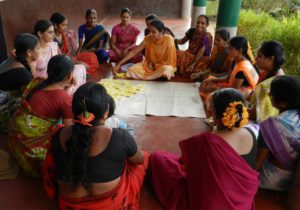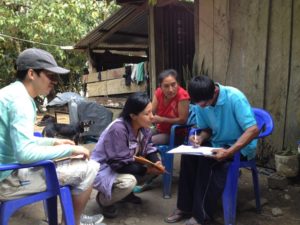
Over the past decade, value chain development has been widely promoted as a catalyst for rural economic growth.
As smallholder farmers become increasingly integrated into value chains, how can scholars and development practitioners ensure that the benefits of participation accrue equitably to both women and men? This was the topic of a workshop hosted by Bioversity International and the World Agroforestry Centre (ICRAF) at the recent Tropentag 2017 conference.
The workshop centered around insights resulting from the testing of 5Capitals-G, a gender-responsive methodology building on the 5Capitals toolkit for assessing the poverty impacts of value chain development. It addresses the principal gaps identified in existing guides for gender-equitable value chain development. These gaps include limited coverage of the way norms influence gender relations, gender-equitable opportunities in collective enterprises, and how value chain development can effectively transform inequitable gender relations.
For this reason, 5Capitals-G examines gender-differentiated asset endowments at the level of both smallholder households and the collective enterprises they are often linked with, and by identifying gender-based constraints shaped by cultural norms and values.
Read more: Piloting gender-responsive research tool 5Capitals-G in three countries
“We started with an overview of strengths and weaknesses of common guides for gender-equitable value chain development designed by international organizations” said Dietmar Stoian, Senior Scientist for Value Chains and Private Sector Engagement at Bioversity, and a coorganizer of the workshop.
“With these in mind, we presented findings from our recent validation of 5Capitals-G as to how women and men have access to, control, and build assets at household and collective enterprise level. Based on this, we can determine the extent to which asset endowments and asset building are gender equitable and adjust value chain interventions accordingly.”
Assessing the poverty impacts of value chain development
Addressing the principal gaps identified in existing guides for gender-equitable value chain development, Bioversity International and ICRAF have joined forces to strengthen the gender dimension of 5Capitals. This new version of the methodology allows for the establishment of gender-responsive baselines and the assessment of gender-differentiated impacts of value chain development among smallholders and other resource-poor groups involved in value chains.
“Two interrelated ideas underpin the design of 5Capitals-G: the poor’s access to assets is a critical entry point for their effective participation in value chains, and the poor’s capacity to build assets through value chain engagement can provide a viable pathway out of poverty,” explained Jason Donovan, Leader for Value Chains and Transformational Change at ICRAF.
“5Capitals-G provides insight into what assets are available in households and collective enterprises, which of these are more controlled by men or women, and which are managed jointly. We are particularly interested in understanding positive feedback loops between asset building at household and asset building at enterprise level.”
Insights from Asia and Latin America
5Capitals-G has been tested across diverse settings in Guatemala, India and Peru, providing valuable insights for improving the design of the tool and guidance for the interpretation of results. These adjustments ensure that practioners will be able to count on a validated methodology for enhancing the design, implementation and assessment of gender-equitable value chain development initiatives.

Hugo Lamers, Associate Scientist in Socioeconomics and Marketing at Bioversity International, used the methodology in the value chains of non-timber forest products such as mango, murugulu (Garcinia indica) and uppage (Garcinia gummigatta) in Karnataka, India.
“Besides taking care of domestic activities, women contributed substantially to income generation through wage labour, farming and collection of forest products,” said Lamers. “We learned that the major bottleneck for women’s participation in local cooperatives is the rule of ‘one member per household’, resulting in a largely male-dominated member base of most cooperatives.”
Gennifer Meldrum, Research Fellow in Nutrition, Marketing and Diversity at Bioversity International, tested the methodology with local partners in millet value chains in Tamil Nadu and Madhya Pradesh, India.
“The collective enterprise we studied has contributed to asset building across all the five capitals. Women’s participation in cooperative leadership and millet value chain activities are strongly encouraged by the Federation,” she said. “However, a male bias remains due to women’s limitations in terms of time and mobility. Physical assets households have acquired through value chain participation are very rarely controlled by women alone, but often benefit the household as a whole.”
Read more: Gender and forestry gain increasing attention worldwide
Further testing of 5Capitals-G was done in the cocoa value chain in Peru. “In addition to the important role women play in the production of cocoa, we were surprised to discover the strong influence they had in production and marketing decisions,” said Trent Blair, Markets and Value Chain Specialist at ICRAF.
“We realized that a stronger role of women in cocoa and other value chains in Peru is hampered by their limited access to information, technical assistance and training. This requires specific efforts for targeted value chain development interventions to ensure equitable capacity development.”

Stoian, together with local partners in Petén, Guatemala, tested 5Capitals-G in value chains of valuable woods including mahogany and tropical walnut, and non-timber forest products such as Chamaedorea palm and Maya nut (Brosimum alicastrum).
“We found evidence that under given conditions income derived from forest products can help people move out of poverty. In terms of reinvestment of forest-based income we learned that decision making at household level was rather equitable with regard to building human and social capitals, while investment decisions on natural, physical and financial capitals were more skewed toward men,” he shared.
“At the level of community forest enterprises, women have recently assumed stronger roles in production and decision making, particularly as regards non-timber forest products, but timber activities and related decisions continue to be largely a male domain.”
Implications for gender-equitable value chain development
“Gender dimensions of access to and control over assets and other resources have an important impact on the opportunities and constraints that women and men face when participating in value chain development initiatives,” said Ana María Paez Valencia, Gender Social Scientist at ICRAF, who moderated the workshop.
In synthesizing the discussion, she pointed out that differential access and control over assets has implications on women’s bargaining position within households to make strategic household and life decisions, as well as their ability to assume new roles or opportunities resulting from value chain initiatives.
“Looking forward, it would be interesting to use 5Capitals-G for insights into the impact of the gender asset gap on household livelihood outcomes in the context of value chain development; and to better understand the trade-offs between increased value chain engagement of women and the time they invest in other activities including those related to household care,” she added.
Outlook
Participants at the workshop expressed interest in 5Capitals-G, which will be available in early 2018, along with the documented findings of the case studies. As Stoian and Donovan summarized at the end of the workshop: “5Capitals-G will be a key methodology for all practitioners interested in asset-based approaches to value chain development with a gender lens.”
By Susan Onyango, originally published at ICRAF’s Agroforestry World.
This work was supported by the CGIAR Research Programs on Policies, Institutions and Markets (PIM) and CGIAR Research Programs Forests, Trees and Agroforestry (FTA), which are supported by CGIAR Fund Donors.
Bioversity International and ICRAF thank Lutheran World Relief, Rainforest Alliance and USAID for funding this work.











